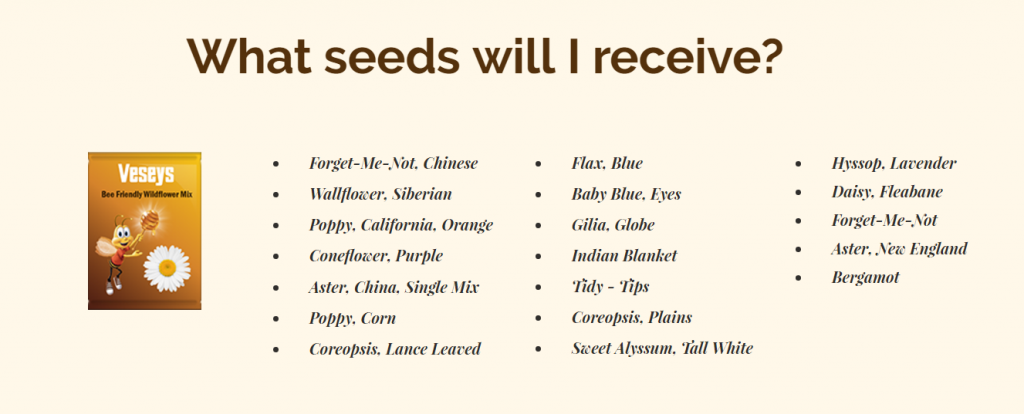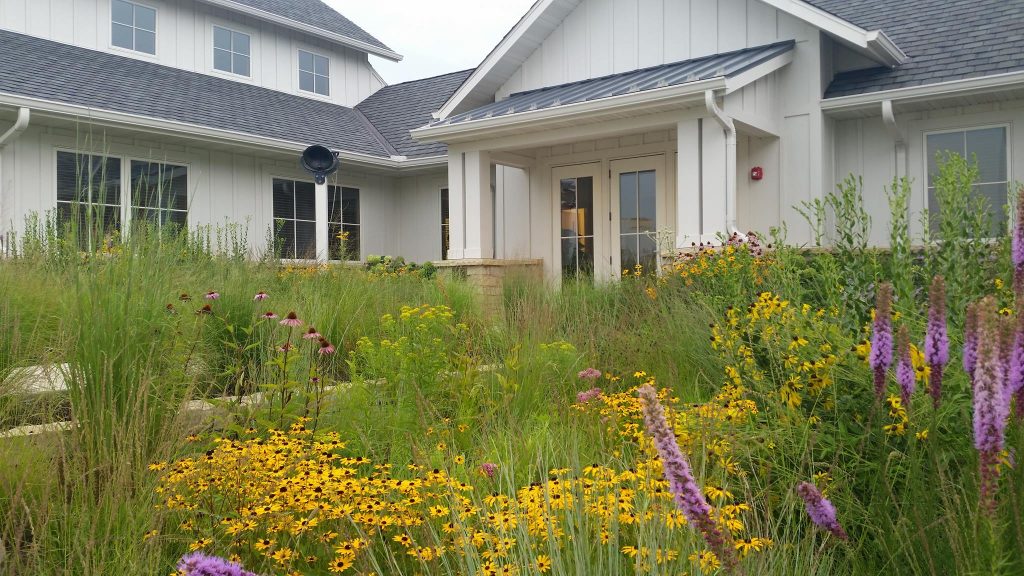
Another example of a poorly-designed “wildflower” seed mix to entice the public to engage in conservation efforts with Cheerios’ #BringBackTheBees campaign (see previous post on DuneCraft’s “Native” Perennial Seed Bombs). Really, how hard is it to consult an ecologist or botanist for efforts like these?
And what a lesson in providing both common and scientific names. It’s not possible to identify fully what is even in the mix from the list of common names they provided. Even the list of common names is only listed on the Canadian version of the site, not on the American version. EDIT: I reached out to Veseys, who provided the seed mixes, and their horticulturist was able to provide to me a list of the scientific names (after a little bit of back-and-forth – e.g. they first claimed to have included Erysimum scoparium in the mix, a species endemic to the Canary Islands, but later confirmed it was actually the much more common Erysimum × marshallii/Cheiranthus × allionii) . I have updated the table below.
The species in the Bring Back the Bees wildflower seed mix come from all around the world with no attempt to plant a mix of flowers native to North America, where seed packets were shipped. Nor are most of the species perennial. They will briefly provide some nectar and pollen resources to insects for a year or two, but soon be out-competed by perennial weeds and invasive species and look downright messy.
Please don’t plant these. Search for a native plant nursery or native plant society near you to find out how you can really help your local nature. Plant wildflowers (and grasses and sedges and rushes and ferns and trees and shrubs) that are native to your area. Support NATIVE bee and other habitat conservation efforts. Learn more at the Native Bee Awareness Initiative, the Xerces Society, or from a native plant society near you.
I never like raining on anyone’s nature parade, but greenwashed initiatives like this one frustrate me. They may do more harm than good.
— Jacquelyn Gill (@JacquelynGill) March 15, 2017
100,000,000 seeds / 43,560 square feet in an acre / 40 seeds per square foot = 57 acres. #bringbackthebees #justsaying
— NW MN Biologist (@NwMnBiologist) March 16, 2017
“Bee Friendly” Wildflower Mix by Veseys/Cheerios
The species highlighted in green are the only ones appropriate for planting in my area in Illinois. But please buy them from a local native plant nursery or gather seeds with permission from the landowner.
| Common Name on Website | Assumed Scientific Name | Life Cycle | Origin |
| Forget-Me-Not, Chinese | Cynoglossum amabile | Annual | Asia |
| Wallflower, Siberian | Erysimum × marshallii (syn. Cheiranthus × allionii) | Biennial/Perennial | Europe |
| Poppy, California, Orange | Eschscholzia californica | Annual/Perennial | North America – West Coast |
| Coneflower, Purple | Echinacea purpurea | Perennial | North America – Eastern |
| Aster, China, Single Mix | Callistephus chinensis | Annual/Biennial | Asia – Eastern |
| Poppy, Corn | Papaver rhoeas | Annual | Europe |
| Coreopsis, Lance Leaved | Coreopsis lanceolata | Perennial | North America – Eastern |
| Flax, Blue | Linum usitatissimum | Perennial | Europe |
| Baby Blue, Eyes | Nemophila menziesii | Annual | North America – West Coast |
| Gilia, Globe | Gilia achilleifolia | Annual | North America – West Coast |
| Indian Blanket | Gaillardia pulchella | Annual | North America – West Coast |
| Tidy-Tips | Layia platyglossa | Annual | North America – West Coast |
| Coreopsis, Plains | Coreopsis tinctoria | Annual | North America – Midwest/Northwest |
| Sweet Alyssum, Tall White | Lobularia maritima | Annual | Europe |
| Hyssop, Lavender | Agastache foeniculum | Perennial | North America – Upper Midwest |
| Daisy, Fleabane* | Erigeron annuus | Annual/Biennial | North America |
| Forget-Me-Not | Myosotis alpestris | Unknown | Arctic |
| Aster, New England | Symphyotrichum novae-angliae | Perennial | North America – Eastern |
| Bergamot | Monarda fistulosa | Perennial | North America |
*I guess you can plant this, but it’s a spontaneous weed…

But aren’t many local nurseries selling bought in plants treated with neonicitionids anyway?
I don’t know any native plant nurseries in northern Illinois that use neonics – you can certainly ask around to those in your area!